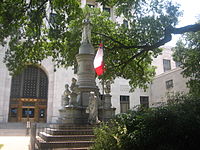 Caddo Parish, bordered by Texas to the west and Arkansas to the north, was created by legislature in 1838 from Natchitoches Parish. The parish was named after the original inhabitants of the area, the Caddo Indians. The 'great raft', or logjam, on the Red River prevented exploration of the area and it wasn't until the 1830s when the logjam was cleared that the area began to flourish. In 1835 the land was bought by the U.S. government from the Caddo Indians. Since then, Caddo Parish and Shreveport have served as the gateway to the West. The boundaries of the parish have undergone many changes and have remained stable only since 1972.
Caddo Parish, bordered by Texas to the west and Arkansas to the north, was created by legislature in 1838 from Natchitoches Parish. The parish was named after the original inhabitants of the area, the Caddo Indians. The 'great raft', or logjam, on the Red River prevented exploration of the area and it wasn't until the 1830s when the logjam was cleared that the area began to flourish. In 1835 the land was bought by the U.S. government from the Caddo Indians. Since then, Caddo Parish and Shreveport have served as the gateway to the West. The boundaries of the parish have undergone many changes and have remained stable only since 1972.
In 1840 the town of Shreveport was founded by Shreve Town Company. The town was named after Captain Henry Miller Shreve, the man hired by the U.S. government in 1838 to clear the logjam on the Red River. In 1855, Shreveport was chosen as the parish seat. Shreveport was an important trade center along the Red River and grew rapidly as settlers poured in on their way to Texas. Amazingly, the town was laid out in such a way that the streets have never needed to be widened. Shreveport also played an important part in the Civil War. Shreveport served as the capital of the state when Baton Rouge fell and was also the site of the last confederacy surrender in 1865. Many believe the "first and last breaths of the confederacy" took place in Caddo Parish.
Prior to the Civil War, Caddo Parish was the leading producer of cotton in the state. However, the Civil War struck Caddo Parish hard, like most of the South. In 1873, the parish was so desperate they tried to break away from Louisiana and join Texas, along with Bossier and De Soto Parish. Fortunately, Caddo Parish experienced a rapid recovery compared to the rest of the South due to their cotton and timber industry. In the early 1900s Caddo Parish experienced several oil booms. In 1911, the first offshore oil well was drilled in the U.S. on Caddo Lake. With the oil boom came an education and industrial boom. By the 1950s Shreveport was the nation's center of production and distribution for natural gas, very successful at oil and gas production, cotton, and timber sales. As synthetics became increasingly more common, Shreveport realized they needed to diversify their economic pursuits. Largely successful, Shreveport continues to grow and progress.